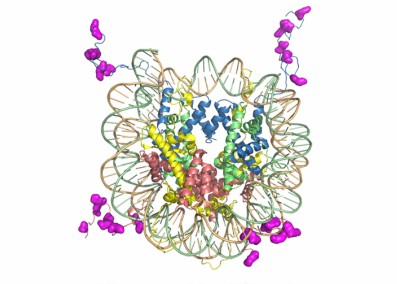Histones have been widely investigated in basic science and research related to disease etiology because their post-translational modifications (PTMs) play an important role in chromatin state modeling. Besides, accurate quantification of histone levels also has shown the potential to discover biomarkers. Mass spectrometry (MS)-based proteomics is the preferred method for large-scale identification and quantification of a broad range of histone PTMs because of the high robustness and reproducibility of analyzing histones and histone PTMs by MS. Creative Proteomics provides quantitative histone PTM analysis services to help clients comprehensively and reliably study the dynamics of histone PTM, which helps understand the function of histone modifications, reveal mechanisms and markers of disease, and find drug targets.
 Fig. 1 Histone modifications. (Huang, H., et al., 2015
Fig. 1 Histone modifications. (Huang, H., et al., 2015
MS-based methods for histone quantification
Immunoprecipitation, western blotting (WB), and immunofluorescence dominate the traditional methods for the study of histone PTMs. However, these methods rely on commercially available antibodies against known modification sites, and there are multiple PTMs of histones. In addition, the search for specific antibodies against different modifications is challenging, often with multiple non-specific interference problems, and antibody detection is only semi-quantitative, leading to the development of more accurate and easier-to-use methods. Advances in MS have revolutionized the ability to measure global changes in histone PTMs. The method typically quantifies more than a few dozen modification states in a single sample. As a result, MS-based histone PTM analysis has become an increasingly popular tool for understanding how genetic and environmental factors influence epigenetic states. Different methods have been developed for the quantification of histone PTM profiles, including:
| MS-based methods for histone quantification |
|---|
| Methods | Description | Suitability for top-down |
|---|
| Metabolic labeling | 2H,13C,18O
SILAC | Yes
Yes |
| Label-free quantification | MS1
MS/MS | NO
Yes |
| Chemical labeling | iTRAQ
Propionic anhydride derivatization
Acetic anhydride derivatization | Yes
Yes
Yes |
| Quantification with an internal standard | Synthesis of standard peptides | No |
Service offering
Creative Proteomics has developed an improved workflow for the quantification of histone PTMs using advanced MS-based methods. The suitable labeling techniques, such as in vivo labeling with SILAC or in vitro labeling with TMT or ITRAQ are all applied in our platform. We are dedicated to offering the perfect solution for the quantitative analysis of histone modifications. All you need to do is tell us the purpose of your experiment and send us your samples, and we will take care of all the follow-up of your project, providing histone extraction, derivatization, and purification and quantitative analysis. Specifically, our service includes the following steps:
- Experimental consultation and design.
- Sample preparation for MS analysis, including histone extraction, derivatization, and purification.
- LC-MS/MS analysis and quantification.
- MS data processing and analysis.
- Bioinformatics analysis.
Sample requirements
- Acceptable samples:
-Protein extracts: 2-5 mg
-Cell samples: 1x108
-Plant tissue samples: 400 mg
-Animal tissue samples: 2000 mg
-Microorganism samples: 400 mg - Sample shipping: Sufficient amount of dry ice for shipping, or consult our technical staff before sending samples.
- Before the formal experiment, we will always test the samples you provide.
A comprehensive and systematic analysis of histone PTM sites and modification levels in normal and diseased tissues is of great importance for understanding the function of histone modifications, revealing the mechanism and markers of tumorigenesis, and so on. If you are interested in our services, or just would like to share some feedback, please contact us. We love to hear from you.
Reference
- Huang, He, et al. "Quantitative proteomic analysis of histone modifications." Chemical reviews 115.6 (2015): 2376-2418.
Our products and services are for research use only.


 Fig. 1 Histone modifications. (Huang, H., et al., 2015
Fig. 1 Histone modifications. (Huang, H., et al., 2015
